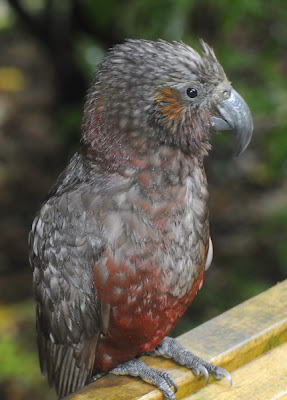Shakespeare, Hamlet Act IV Sc V
It is difficult to get back to writing about nature so soon after my father's passing, but I have decided to do so as, if nothng else, a form of personal therapy. Life, even in retrospect, has to go on.
So, with some difficulty, let me take you back to happier times, in December 2011, when Eileen, Ryan and I were making our rain-soaked circuit of New Zealand's North Island.
So, with some difficulty, let me take you back to happier times, in December 2011, when Eileen, Ryan and I were making our rain-soaked circuit of New Zealand's North Island.
Back then, Mount Bruce was a government captive-breeding facility for New Zealand's endangered birds, particularly the South Island Takahē (Porphyrio hochstetteri). Thanks to Brian Bell of the Wildlife Department I had a private tour, my only chance to see a number of extreme rarities in the flesh. Today it is part of a larger nature reserve, and is open to the public. We could see the star attraction from the visitors' centre balcony...
A Takahē, methodically working its way through the vegetation beneath us. The Takahē, though certainly a gorgeous and exotic, if somewhat ponderous, creature, is far from the most unusual of New Zealand's endemics - it is, basically, a Clydesdale version of the widespread Pukeko or Purple Swamphen (Porphyrio porphyrio). The remarkable thing about it is its history.
Until 1948, the Takahē was believed to have gone the way of New Zealand's other giant flightless birds (including its North Island cousin Porphyrio mantelli). In that year, an ornithologist named Geoffrey Orbell discovered a tiny populaton of living Takahēs high in a glacial valley above Te Anau, in the southwestern part of the South Island. His discovery, once announced in the press, was treated with the astonishment and enthusiasm that might have greeted the announcement of a herd of live Triceratops.
Since then, the Takahē has been the subject of an intense recovery program. There are now populations on a number of offshore islets, and though its numbers are barely above the couple of hundred that Orbell found in 1948 there seems a reasonable chance that it will survive.
I had performed the singular feat, earlier in the year, of missing the extremely tame Takahēs at Tiritiri Matangi Island, so I was glad to see this bird (even if it is a semi-captive) here. It is an iconic creature - one of the few flightless rails to have survived the human onslaught on the Pacific Islands.
As we strolled through the grounds of the centre, Ryan and I came across a small clearing where a staff member was setting out food for a group of eager New Zealand Kākās (Nestor meridionalis). Watching them crowd around the feeders, I assumed that they, like the Takahēs, were semi-captive or, at least, free-flying captive-bred birds.
Except for a few individuals, though, these were almost all perfectly wild birds, taking advantage of a handout. They are descendants of birds introduced into the area in 1996 and 1997, fifty years after the last native Kākās has disappeared from Mount Bruce.
For wild parrots, they were certainly tame - not to mention loaded with obvious personality.
Ryan liked them too, though we both could have done without the rain....
The rain finally got to be a bit too much for Ryan, so we retreated indoors to see the kiwis (no photography allowed), including a white bird hatched earlier in the year, and what may be the most distinctive and unique animal in New Zealand, the Tuatara (Sphenodon punctatus), last survivor of an entire Order of reptiles, the Rhynchocephalia, that otherwise disappeared at the end of the Cretaceous. No, that isn't a big lizard.
Ryan went back to the car to join Eileen, but I wanted to see a few more birds - caged, I admit, but I couldn't resist. This North Island Kōkako (Callaeas cinereus) apparently felt the same way about me. He (I presume) was, it seems, intensely imprinted on humans. He serenaded me repeatedly, and did everything he could to throw himself through the mesh into my arms.
This fine caged male Stichbird (Notiomystis cincta) was much more sedate, and much less interested in me. Of course I saw both these species in the wild (more or less) on Tiritiri Matangi on our visit in March 2011, but by seeing them at Mount Bruce I had a chance to spend time with members of four of the five endemic bird families of New Zealand: kiwis (Apterygidae), nestorid parrots (Nestoridae), Stitchbirds (Notiomystidae) and Wattlebirds (Callaeatidae). I encountered the other family, the New Zealand Wrens (Xenicidae), in 1974 - but, on both my visits in 2011, they stayed out of sight. A reason to go back...


















No comments:
Post a Comment